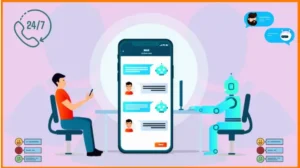Event Schedule | Event Location

The emphasis on employee well-being has taken center stage, particularly under the leadership of women in executive roles.
The digital era has ushered in transformative changes, necessitating a reevaluation of traditional approaches to health within the professional sphere.
Executives, guided by a commitment to fostering holistic employee experiences, are steering organizations toward innovative strategies that prioritize mental, physical, and emotional wellness.
A study by FlexJobs and Mental Health America in 2021 found that 75% of workers experienced burnout.
To see how women leaders are prioritizing employee health in EX, let’s have a look below:
1. Flexible Work Arrangements
Amidst the bustling rhythms of the corporate world, a quiet revolution led by women in executive roles has unfolded—a paradigm shift in the way we approach work arrangements.
They’ve definitely cracked the code for a better work-life balance. And you know what? They’re not just talking about it; they’re putting it into action, giving employees options like working from home.
Your job shouldn’t tie you down to a desk; instead, you should have the freedom to choose where you work. Thanks to these leaders, that’s becoming more common.
It’s a game-changer for reducing stress and making work fit better into our lives. These executives are like superheroes, reshaping the work world.
Apart from “work from home,” these women leaders are also advocating for job-sharing arrangements, where two people split one role. It’s a tag-team approach, ensuring the workload is manageable and everyone gets a breather.
Furthermore, they’re trailblazing the path of compressed workweeks—full-time hours condensed into fewer days. It gives employees extended weekends or more extended periods of time off.
It’s a bold move that acknowledges the importance of downtime and rejuvenation in maintaining a healthy work-life balance.
2. Mental Health Support
An insightful shift led by women in leadership roles has emerged—a heightened emphasis on mental health support.
Within this progressive wave, organizations are becoming beacons of well-being, acknowledging the vital role mental health plays in the overall professional Employee Experience.
A workplace that recognizes the significance of mental well-being (led by women) is perfect, as they understand that a healthy mind is crucial for a thriving workforce.
They’re actively steering organizations to provide tangible support. This encompasses access to counseling services—a lifeline for those navigating the complexities of mental health challenges.
But it doesn’t stop there. These leaders are conducting workshops, creating spaces for employees to engage in meaningful conversations about mental well-being.
To be honest, workplaces are transforming into havens where employees can access resources designed to empower them with coping mechanisms, resilience, and strategies to navigate the intricacies of the mind.
Furthermore, there’s a concerted effort to dismantle the stigma surrounding mental health. Initiatives led by these women leaders are actively fostering environments where discussing mental well-being is not just accepted but encouraged.
It’s a departure from the old norms, where mental health was often relegated to the shadows. Now, it’s stepping into the light, becoming a crucial part of the workplace dialogue.
3. Technology for Well-being
Women leaders are proudly steering organizations toward a tech-savvy approach to employee well-being. They are leveraging technology as a catalyst for fostering healthier, more balanced professional lives.
The integration of wellness apps into the work environment is doing wonders. These handy digital companions offer employees personalized avenues to track and enhance their well-being.
From monitoring physical activity to providing mindfulness exercises, these apps become personalized well-being assistants.
Virtual fitness classes, another jewel in the tech-driven well-being crown, bring the gym to your home office or wherever you choose to work.
These classes, accessible through digital platforms, cater to diverse preferences and schedules, ensuring that employees can prioritize their physical health regardless of their location.
And let’s not forget the online mental health resources—a digital lifeline for those navigating the complex landscape of well-being. These resources, ranging from informative articles to interactive tools, offer support, guidance, and strategies for maintaining good mental health.
In the realm of remote or hybrid work settings, where physical distance may pose challenges, these digital resources become indispensable.
This tech-powered well-being revolution is a great move to empower employees. It’s an acknowledgment that in a digitally connected world, technology can be a force for good, promoting well-being and resilience in the face of modern professional challenges.
As guided by women in executive roles, organizations are embracing these digital allies to ensure that employee well-being isn’t just a goal but a tangible reality in today’s digitally driven workplace.
4. Wellness Programs
For decades, wellness Programs or Employee Assistance Programs (EAP) have been known to make employees happy and relaxed at work. However, in today’s time, a lot of focus is being given to these programs, mainly by women leaders!
These programs represent a holistic approach to employee well-being, acknowledging that true wellness encompasses the physical, mental, and emotional facets of our lives.
A workplace where wellness isn’t just a word but a lived experience is the one that’s needed in the present day and age! And women leaders are thankfully rooting for it.
Talking about it, fitness challenges become communal endeavors, fostering a sense of camaraderie among employees. These challenges go beyond the conventional gym routine; they’re creative and inclusive, encouraging everyone to find joy in staying active.
Mindfulness sessions, another cornerstone of these wellness programs, offer employees a mental retreat amidst the demands of their workday.
Guided meditation, stress-relief techniques, and moments of reflection become integral components, contributing to a workplace culture that values the well-being of the mind.
On the other hand, educational workshops, often curated with precision, delve into the intricacies of nutrition and stress management.
They’re interactive sessions equipping employees with practical tools to make informed choices about their well-being. It’s about empowering individuals to understand the connection between what they eat, how they manage stress, and their overall health.
5. Inclusive Health Policies
Women leaders are trying their best to have an inclusive vision of health policies within the workplace. These policies will be a reflection of a commitment to recognizing and addressing the unique and diverse health needs of all employees.
Inclusive health policies that go beyond the conventional, acknowledging the specific needs of various employee populations.
One significant aspect is maternal health, where these policies ensure that expecting mothers receive not just standard support but tailored assistance that considers the distinct phases of pregnancy and postpartum.
Family planning, another focal point of these inclusive policies, recognizes that employees navigate various life stages.
These policies provide a supportive framework, offering resources and flexibility for individuals and families to make informed decisions about their family planning journey.
Moreover, these policies extend a supportive hand to caregivers, understanding the challenges they may face in balancing work and caregiving responsibilities.
It’s not just about acknowledging the role of caregivers but actively creating policies that offer practical solutions, such as flexible schedules or support networks.
In the capable hands of women in leadership roles, inclusive health policies become a cornerstone of workplace culture—a declaration that the organization values the individual health journeys of every employee.
6. Digital Health Platforms
The compass of wellness strategies is pointing towards a pivotal destination—digital health platforms. Guided by women in executive roles, organizations are leveraging digital tools to redefine the contours of employee well-being.
Wearable devices that go beyond being gadgets; they’re personalized health companions. Employees can wear these devices, and voila, they’re on a journey of tracking their physical activity.
It’s obviously not just about counting steps; it’s a dynamic tool that provides insights into daily movement, encouraging individuals to stay active in ways that suit their lifestyle.
Telemedicine services, another jewel in the digital health crown, bring healthcare to the fingertips of employees. Virtual consultations and medical advice through the screen—it’s healthcare convenience redefined.
These services break down geographical barriers and ensure that employees can access healthcare when and where they need it.
And then there’s the wizardry of data analytics—a strategic move to understand and address health trends among employees. It deciphers the story that the data tells.
This insight allows organizations to tailor wellness initiatives, addressing specific health needs and fostering a proactive approach to employee well-being.
7. Cultivating a Supportive Culture
By nature, women are quite supportive, and when they become leaders, they take the approach a notch higher for EX. That’s why they craft a culture that goes beyond the surface—a culture that breathes and thrives on the well-being of its employees.
Thanks to these women leaders, they’re fostering a culture that prioritizes well-being means creating spaces where employees feel heard, valued, and encouraged to share their thoughts and concerns.
Work-life balance, often elusive in the fast-paced professional world, takes center stage in this cultural masterpiece.
The good thing is that these leaders understand the importance of setting boundaries, ensuring that employees have the space and time to recharge outside of work, and nurturing a sense of balance that sustains over the long term.
Additionally, the brushstrokes of inclusivity and support are intricately woven into the fabric of this culture.
It’s a culture about actively promoting an environment where differences are not just accepted but celebrated. It’s a culture where support isn’t a rare commodity but a shared ethos, fostering collaboration and a sense of belonging.
8. Educational Initiatives
The nurturing of a culture of health and wellness through educational initiatives is what’s needed today, so women leaders are making sure of it!
Educational initiatives that go beyond routine training programs are doing good in the organizations. These are dynamic endeavors designed to raise awareness, like rays of sunlight penetrating through the professional landscape.
These initiatives are not about dictating rules; they’re about empowerment, enlightening employees about the importance of their well-being and the profound impact it has on their professional journey.
Seminars become vibrant forums within this educational canvas. They’re not just gatherings; they’re interactive spaces where experts share insights, employees exchange experiences, and a collective understanding of the significance of health and wellness deepens.
And then there are resources, carefully curated to be more than just pamphlets.
Whether it’s understanding the fundamentals of nutrition, stress management techniques, or avenues for mental health support, these resources become beacons, ensuring that every employee has access to the knowledge needed to actively participate in their well-being.
Women leaders are ticking off a checklist and instilling a culture where learning about well-being is a continuous journey.
The Bottom Line!
As women in executive roles continue to shape the narrative of workplace well-being, it’s evident that the evolution is inevitable.
The 2021 research findings from The Workforce Institute at UKG and Workplace Intelligence echo a powerful truth: a staggering 74% of employees affirm that their effectiveness at work is intricately linked to the profound sense of being heard.
As we navigate the future of work, this insight invites organizations to go beyond the surface to recognize that women leaders are shaping EX by promoting mental and physical well-being in the best way they can!



